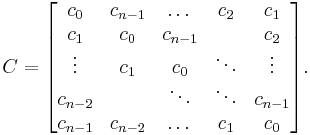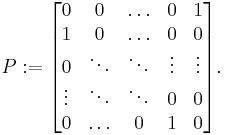Circulant matrix
In linear algebra, a circulant matrix is a special kind of Toeplitz matrix where each row vector is rotated one element to the right relative to the preceding row vector. In numerical analysis, circulant matrices are important because they are diagonalized by a discrete Fourier transform, and hence linear equations that contain them may be quickly solved using a fast Fourier transform. They can be interpreted analytically as the integral kernel of a convolution operator on the cyclic group  In cryptography, a circulant matrix is used in the MixColumns step of the Advanced Encryption Standard.
In cryptography, a circulant matrix is used in the MixColumns step of the Advanced Encryption Standard.
Contents |
Definition
An  circulant matrix
circulant matrix  takes the form
takes the form
A circulant matrix is fully specified by one vector,  , which appears as the first column of
, which appears as the first column of  . The remaining columns of
. The remaining columns of  are each cyclic permutations of the vector
are each cyclic permutations of the vector  with offset equal to the column index. The last row of
with offset equal to the column index. The last row of  is the vector
is the vector  in reverse order, and the remaining rows are each cyclic permutations of the last row. Note that different sources define the circulant matrix in different ways, for example with the coefficients corresponding to the first row rather than the first column of the matrix, or with a different direction of shift.
in reverse order, and the remaining rows are each cyclic permutations of the last row. Note that different sources define the circulant matrix in different ways, for example with the coefficients corresponding to the first row rather than the first column of the matrix, or with a different direction of shift.
Eigenvectors and eigenvalues
The eigenvectors of a circulant matrix are given by
where  are the n-th roots of unity and
are the n-th roots of unity and  is the imaginary unit.
is the imaginary unit.
The corresponding eigenvalues are then given by
Circulant determinant
As a consequence of the explicit formula for the eigenvalues above, the determinant of circulant matrix can be computed as:
Since taking transpose does not change the eigenvalues of a matrix, an equivalent formulation is
Properties
- We have
where P is the 'cyclic permutation' matrix given by
- The set of
 circulant matrices forms an n-dimensional vector space; this can be interpreted as the space of functions on the cyclic group of order n,
circulant matrices forms an n-dimensional vector space; this can be interpreted as the space of functions on the cyclic group of order n,  or equivalently the group ring.
or equivalently the group ring.
- Circulant matrices form a commutative algebra, since for any two given circulant matrices
 and
and  , the sum
, the sum  is circulant, the product
is circulant, the product  is circulant, and
is circulant, and  .
.
- The eigenvectors of a circulant matrix of a given size are the columns of the unitary discrete Fourier transform matrix of the same size. The latter matrix is defined by
-
- Thus, the matrix
 diagonalizes C. In fact, we have
diagonalizes C. In fact, we have
- where
 is the first column of
is the first column of  . Thus, the eigenvalues of
. Thus, the eigenvalues of  are given by the product
are given by the product  . This product can be readily calculated by a Fast Fourier transform.[1]
. This product can be readily calculated by a Fast Fourier transform.[1]
In linear equations
Given a matrix equation
where  is a circulant square matrix of size
is a circulant square matrix of size  we can write the equation as the circular convolution
we can write the equation as the circular convolution
where  is the first column of
is the first column of  , and the vectors
, and the vectors  ,
,  and
and  are cyclically extended in each direction. Using the results of the circular convolution theorem, we can use the discrete Fourier transform to transform the cyclic convolution into component-wise multiplication
are cyclically extended in each direction. Using the results of the circular convolution theorem, we can use the discrete Fourier transform to transform the cyclic convolution into component-wise multiplication
so that
This algorithm is much faster than the standard Gaussian elimination, especially if a fast Fourier transform is used.
Analytic interpretation
Circulant matrices can be interpreted geometrically, which explains the connection with the discrete Fourier transform.
Consider vectors in  as functions on the integers with period n, (i.e., as periodic bi-infinite sequences:
as functions on the integers with period n, (i.e., as periodic bi-infinite sequences:  ) or equivalently, as functions on the cyclic group of order n, (
) or equivalently, as functions on the cyclic group of order n, ( or
or  ) geometrically, on (the vertices of) the regular n-gon: this is a discrete analog to periodic functions on the real line or circle.
) geometrically, on (the vertices of) the regular n-gon: this is a discrete analog to periodic functions on the real line or circle.
Then, from the perspective of operator theory, a circulant matrix is the kernel of a discrete integral transform, namely the convolution operator for the function  this is a discrete circular convolution. The formula for the convolution of the functions
this is a discrete circular convolution. The formula for the convolution of the functions  is
is
 (recall that the sequences are periodic)
(recall that the sequences are periodic)
which is the product of the vector of  by the circulant matrix.
by the circulant matrix.
The discrete Fourier transform then converts convolution into multiplication, which in the matrix setting corresponds to diagonalization.
Application in graph theory
In graph theory, a graph or digraph whose adjacency matrix is circulant is called a circulant graph (or digraph). Equivalently, a graph is circulant if its automorphism group contains a full-length cycle. The Möbius ladders are examples of circulant graphs, as are the Paley graphs for fields of prime order.
References
- ^ Golub, Gene H.; Van Loan, Charles F. (1996), "§4.7.7 Circulant Systems", Matrix Computations (3rd ed.), Johns Hopkins, ISBN 978-0-8018-5414-9
External links
- R. M. Gray, Toeplitz and Circulant Matrices: A Review
- Weisstein, Eric W., "Circulant matrix" from MathWorld.
|
||||||||||||||












![\ \mathbf{x} = \mathcal{F}_{n}^{-1}
\left [
\left (
\frac{(\mathcal{F}_n(\mathbf{b}))_{\nu}}
{(\mathcal{F}_n(\mathbf{c}))_{\nu}}
\right )_{\nu \in \mathbf{Z}}
\right ]^T.](/2012-wikipedia_en_all_nopic_01_2012/I/b9312f61392cd3469440a232ac72f442.png)